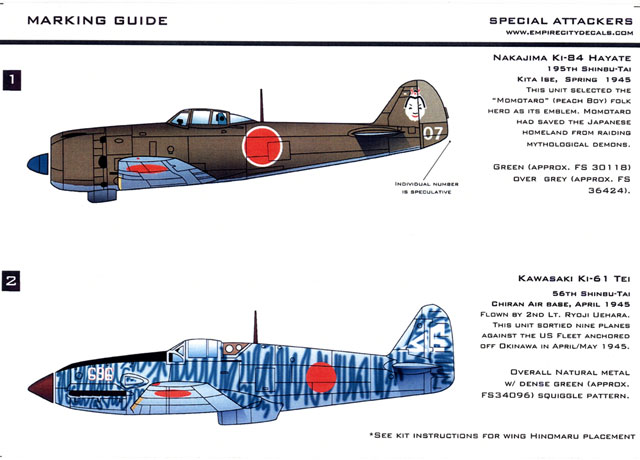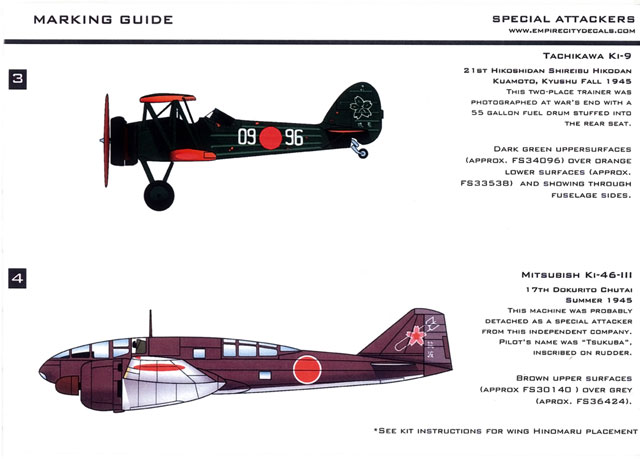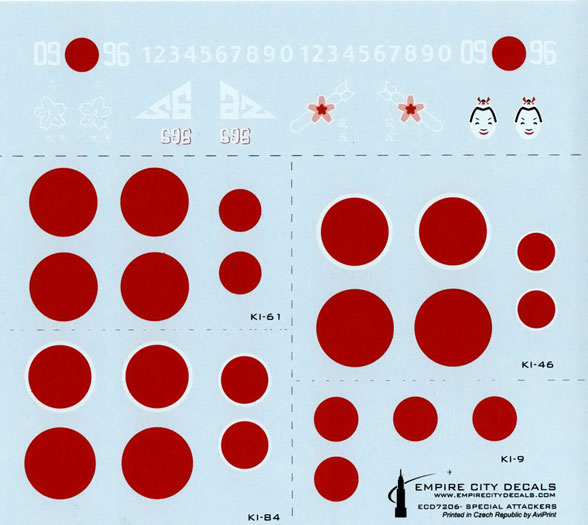|
S u m m a r y
|
| Catalogue Number and
Description: |
Empire City Decals No. ECD7206 -
Special Attackers |
| Scale: |
1/72 |
| Contents and Media: |
One decal sheet, two printer instruction cards |
| Price: |
ECD7206
USD$10.00 available online from their
website |
| Review Type: |
FirstLook |
| Advantages: |
Interesting subjects, well printed
with good register. |
| Disadvantages: |
|
| Recommendation: |
Recommended |
Reviewed by
Rodger Kelly

HyperScale is proudly sponsored by Squadron.com
Special
Attackers is the latest release from Empire City Decals the New York City, USA
based company. This new release keeps with their policy (or is that passion?)
for producing decals for other than Mustangs and Messerschmitts.
This time we
are taken on a journey back to 1945 and the final bitter days of the ‘Kamikaze’
or ‘Divine Wind’ tactics of the Pacific War. Whatever you call it, it involved
the self-sacrifice of willing pilots of the Japanese military diving their
bomb-laden aircraft onto decks of the ships of the U.S. and British Pacific
Fleets in the desperate final defence of their home islands.

EC7206
provides markings for four of these aircraft:
-
Nakajima Ki-84 Hayate (Frank)
of the 195th Shinbu-Tai based at Kita Ise, in the spring of 1945.
The placement guide advises that machine is finished in green upper
surfaces over light grey undersides and offers FS30118 as an approximate
match for the green and FS36424 as an approximate match for the light grey.
The machine wears an appropriate tail marking of the ‘Momotaro’ (Peach Boy)
Japanese folk hero who saved the Japanese homeland from raiding mythological
demons.
-
Ki-61 Tei (Tony) of
the 56th Shinbu-Tai based at Chiran Air Base in the April of 1945. This
option is in overall natural metal finish with green “palm” camouflage.
Machine was piloted by Second Lieutenant Ryoji Uehara and was on of nine
aircraft that were sent to attack the U.S. fleet anchored off the island of
Okinawa in April/May of 1945. The placement guide advises FS34096 to be an
approximate match for the green of the “palm” disruptive pattern camouflage.
-
Tachikawa Ki-9 (Spruce)
of the 21st Hikoshidan
Shireibu Hikodan at Kuamoto, Kyushu in the autumn of 1945. The machine is
dark green upper surfaces over trainer orange undersides. The placement
guide advises that dark green is approximately FS34096 and the orange to be
an approximate match to FS33538.
-
Ki-46-III (Dinah)
of the 17th Dokurito Chutai flown by a pilot named as ‘Tsukba’ in the summer
of 1945. The aircraft is in camouflage finish of brown upper surfaces
(approximately FS30140) over light grey undersides (approximately FS36424).
The placement guide advises that this aircraft was probably detached
from this independent unit as a special attacker.

Apart from
the individual markings, the sheet includes enough hinomaru to produce every
option as well as two complete sets of numbers from 0 to 9 in the unique font
seen on Japanese WWII aircraft. The decals themselves are silk screen printed
and produced by the Czech Republic based company AviPrint. They are thin, sharp
and in perfect register. The colours on the image of the decal sheet may look a
little dark, they are not. I have deliberately darkened the image so that the
white ones are visible. A word about AviPrint decals here. My experience with
them is that they are beautiful and shrink down over surface detail without any
problems at all but they are thin and easily torn if you don’t treat them with
care. Ensure you use plenty of water to float them into position and you won’t
have a problem.

The
suggested kits are the Hasegawa for the Ki-84, the Fine Molds Ki-61, the
Choroszy Modelbud (a resin kit) for the Ki-9 and the Hasegawa one for the
Ki-46.
Support
information/placement guide is via two thin cardboard cards (great stuff as it
keeps the decal sheet from bending and creasing in the post) that carry left
hand side colour profiles for each option printed along with individual notes
for each aircraft on one with the other carrying a list of references and
suggested kits and a short discourse on the misconceptions of the camouflage
colours worn by the aircraft of the Japanese air arms in WWII.
The decal
sheet, placement/information support guides come packed in a clear plastic
zip-loc bag.
This is an
excellent sheet from Empire City Decals, it provides markings for four unique
machines that have not been previously available in decal format before.
The sheet is
also available in 1/48 scale as ECD48-06.
Recommended.
Postscript
If you
are new to the world of WWII Japanese aviation and want learn what Shinbu-Tai
and Hikoshidan Shireibu Hikodan mean as well as advice on the camouflage and
colours worn their aircraft, take a trip to j-aircraft.com at
www.j-aircraft.com
Thanks to Empire City Decals for the review samples
Empire City Decals are
available online from
their website
Review Copyright © 2007 by Rodger Kelly
Page Created 10 October, 2007
Last updated 24 December, 2007
Back to HyperScale Main Page
Back to Reviews Page
|
Home
| What's New |
Features |
Gallery |
Reviews |
Reference |
Forum |